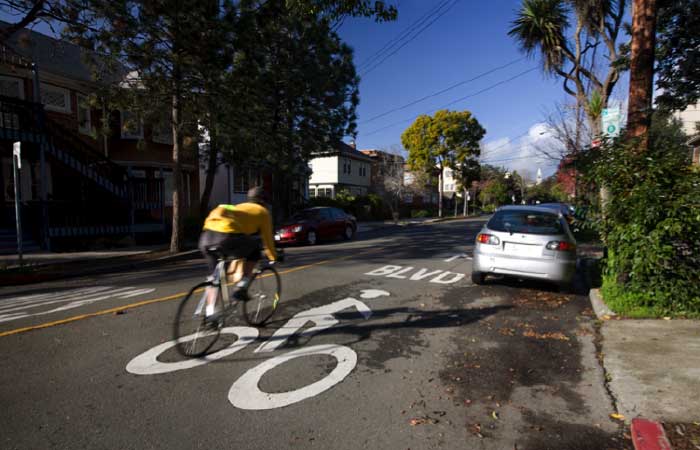The City of Berkeley is a well-known leader in environmentalism, social justice, and public health. Given that active transportation plays an integral role in each of these fields, it’s no surprise that Berkeley has long been one of the most bicycle- and pedestrian-friendly cities in California. Berkeley was one of the early adopters of complete streets principles, and has historically invested considerably in bicycle, pedestrian, and transit projects. But over the past few years, as neighboring cities like San Francisco, Oakland, and El Cerrito have embraced innovative complete streets designs that prioritize street safety over automobile efficiency, Berkeley surprisingly appears to be falling behind.
If we wrote this post 10 years ago, it would be telling a slightly different story. While other Bay Area cities had not yet fully embraced the idea of multimodal streets, Berkeley was leading the charge. It had implemented a network of bicycle boulevards featuring bold signage and bicycle-activated traffic signals that made bicycling easier than ever. It had just opened a $6.4 million bicycle and pedestrian bridge across I-80 to connect to the Berkeley marina. It was in the process of completing a road diet on Marin Avenue to calm traffic on one of the city’s major thoroughfares. Most importantly, it was innovating— trying out pilot programs to make its streets safer even if they didn’t work out so well, like the infamous pedestrian flag program. There was still a lot of work to be done—there were some gaps at unsignalized intersections along the bicycle boulevards, and many major corridors still lacked basic bicycle and pedestrian safety measures—but there was a sense the city was heading in the right direction while others lagged behind.
Injured In an Accident? Learn More how GJEL can Help You Below
Berkley Personal Injury Attorneys
- Fatal Car Accident Attorney in Berkeley
- Berkeley Amputation Injury Attorneys
- Berkeley Bicycle Accident Attorneys
- Berkeley Car Accident Lawyers
- Berkeley Motorcycle Accident Lawyers
- Berkeley Brain Injury Lawyers
- Berkeley Truck Accident Lawyers
- Berkeley Wrongful Death Lawyers
But how quickly things change. Now, in 2014, San Francisco and Oakland have leapt ahead of Berkeley in designing safe streets, taking on major national leadership roles within NACTO in the process. San Francisco has aggressively implemented its bicycle plan and prioritized pedestrian safety through its WalkFirst program. Oakland can’t build bike lanes fast enough and is completely rethinking Telegraph Ave to improve safety and comfort for people who walk, bike, and take transit. Even El Cerrito has joined the complete streets party as it plans to reshape San Pablo Avenue, the city’s main thoroughfare.
Meanwhile, Berkeley has seemingly stalled. Berkeley is the most dangerous city of its size in California for bicyclists and pedestrians. It ranks fourth in the Bay Area for total bicycle and pedestrian collisions despite a population rank of 11th. While Berkeley’s investment in education campaigns to encourage safe behavior is a good start, it misses the bigger issues—helmet use for bicyclists (and for that matter, pedestrians) might reduce the severity of some injuries, but it does little to reduce risk of collisions.
Berkeley has not aggressively targeted unsafe street designs to improve pedestrian safety. It has seen a number of terrible incidents, most often related to the number of poorly marked and unprotected crosswalks on busy streets. Most recently, Joseph Luft, a 98-year-old psychology professor at San Francisco State, was killed crossing Sacramento Street at Bancroft Way, a busy intersection that features a crosswalk but no traffic signal. Berkeley is plagued by countless similar multiple threat situations which places pedestrians (particularly seniors and children) at high risk. Some of the worst cases have involved children: Zachary Cruz, a kindergartner, was killed crossing the intersection of Derby and Warring with an after school group. Despite a highly automobile-oriented intersection design built to facilitate fast automobile travel at the expense of short, safe pedestrian crossings, there still appears to be no plans to change the design of this intersection (the driver was never cited or charged as occurs in many incidents of traffic violence). Another frustrating incident occurred at Malcolm X Elementary in South Berkeley: a six year old was hit by a car while walking in a crosswalk at the intersection of Ashby and Ellis (another unsignalized intersection despite the presence of an elementary school adjacent to a fast thoroughfare). Safety improvements were bogged down in bureaucracy and only came to fruition after an extensive grassroots campaign by parents.
Safe designs for bicyclists have also lagged behind. Between 2005 and 2010, Berkeley had 819 bike crashes. Issues of bicycle safety were brought to the forefront when Schlomo Bentin, a neuropsychologist, was killed while riding on Bancroft Way by UC Berkeley. Approximately 25% of pedestrian collisions and 20% of bicycle collisions occur adjacent to UC Berkeley, an area in which most of the streets are again designed to move large volumes of automobiles quickly despite the fact that only 25% of the university’s commuters drive to work. The City has even been maligned for the fact that it still hasn’t undertaken critical safety improvements on its bicycle boulevards, such as this terrifying unprotected crossing at Adeline and Russell. While unthinkable ten years ago, it’s likely that people will soon be safer walking or biking on Telegraph Ave in Oakland or San Pablo Ave in El Cerrito than these same streets in Berkeley.
Not only does Berkeley continue to prioritize automobile efficiency over safety, it has actually made more recent headlines fighting against complete streets and sustainable transportation projects. Rather than targeting speeding drivers or educating roadway users to act more safety, police at UC Berkeley issued punitive tickets for hundreds of dollars to bicyclists for minor violations. Berkeley rejected AC Transit’s bus rapid transit plans for Telegraph Ave, the second-busiest transit corridor in the East Bay, because a vocal minority of residents and merchants were concerned about impacts to traffic and parking. Similar forces have diluted AC Transit’s plans for improvements for Line 51 on University and College Avenues. Berkeley neighbors even fought a proposal for a parklet at the corner of Shattuck and Rose—an incredibly over-engineered intersection which has so little public space that scores of Cheeseboard pizza-goers eat their lunch in the streets median—because residents thought it would attract homeless people and become “People’s Park North.”
At times, planning for pedestrians and bicyclists doesn’t even seem to register: the Tom Bates Regional Sports Complex opened in 2008 on the bay-side of I-80 without providing any accessibility improvements to Gilman St. Kids playing soccer after school must either undertake a dangerous trip across a hairball interchange or rely on their parents to drive them there (the interchange is planned to be converted to roundabouts, but the project has been stalled for years and no interim safety measures have been implemented).
Why has Berkeley fallen behind Oakland, San Francisco, El Cerrito, and other Bay Area cities? Part of the explanation probably relates to what makes Berkeley, well, Berkeley. There is a subculture of misplaced environmentalism in Berkeley that strives to preserve the good old days and save the city from changes by newcomers or outsiders. What this amounts to is a strong sense of NIMBYism from a vocal segment of the population—a minority of perhaps 15-25 percent that has a disproportionate effect on city policies. This culture seems to trickle down to the city’s traffic engineering decisions: maintaining the status quo is welcomed until somebody (like the Malcolm X Elementary parents) sufficiently lobby for change.
Berkeley hasn’t seemed to acknowledge that it had real, serious problems when it comes to street safety—problems that run contrary to the very principals of environmentalism, social justice, and public health for which the city has traditionally been a leader. Embracing a status quo in which seniors, children, students, transit riders, low income residents, and other groups are exposed to greater risk of injury or death and are forced to deal with subpar facilities is not what Berkeley stands for.
Let’s hope this post is completely wrong, and that Berkeley is making ample progress behind the scenes that will soon reshape its streets to be safer, more inclusive, and more sustainable. Berkeley has made a number of recent major accomplishments that should not be overlooked, like the approval of its Downtown Plan. Change certainly takes time, but interim safety improvements could be implemented quickly. If New York, Los Angeles, San Francisco, and Oakland can make their streets safer, Berkeley can too.




 AI-search
AI-search  Email
Email